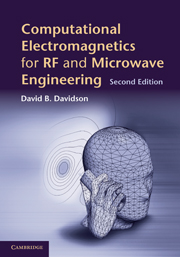Book contents
- Frontmatter
- Dedication
- Contents
- Preface to the second edition
- Preface to the first edition
- Acknowledgements
- To the reader
- List of notation
- 1 An overview of computational electromagnetics for RF and microwave applications
- 2 The finite difference time domain method: a one-dimensional introduction
- 3 The finite difference time domain method in two and three dimensions
- 4 A one-dimensional introduction to the method of moments: modelling thin wires and infinite cylinders
- 5 The application of the FEKO and NEC-2 codes to thin-wire antenna modelling
- 6 The method of moments for surface modelling
- 7 The method of moments and stratified media: theory
- 8 The method of moments and stratified media: practical applications of a commercial code
- 9 A one-dimensional introduction to the finite element method
- 10 The finite element method in two dimensions: scalar and vector elements
- 11 The finite element method in three dimensions
- 12 A selection of more advanced topics in full-wave computational electromagnetics
- Appendix A The Whitney element
- Appendix B The Newmark-β time-stepping algorithm References
- Appendix C On the convergence of the MoM Reference
- Appendix D Useful formulas for simplex coordinates
- Appendix E Web resources
- Appendix F MATLAB files supporting this text
- Index
- References
2 - The finite difference time domain method: a one-dimensional introduction
Published online by Cambridge University Press: 05 July 2014
- Frontmatter
- Dedication
- Contents
- Preface to the second edition
- Preface to the first edition
- Acknowledgements
- To the reader
- List of notation
- 1 An overview of computational electromagnetics for RF and microwave applications
- 2 The finite difference time domain method: a one-dimensional introduction
- 3 The finite difference time domain method in two and three dimensions
- 4 A one-dimensional introduction to the method of moments: modelling thin wires and infinite cylinders
- 5 The application of the FEKO and NEC-2 codes to thin-wire antenna modelling
- 6 The method of moments for surface modelling
- 7 The method of moments and stratified media: theory
- 8 The method of moments and stratified media: practical applications of a commercial code
- 9 A one-dimensional introduction to the finite element method
- 10 The finite element method in two dimensions: scalar and vector elements
- 11 The finite element method in three dimensions
- 12 A selection of more advanced topics in full-wave computational electromagnetics
- Appendix A The Whitney element
- Appendix B The Newmark-β time-stepping algorithm References
- Appendix C On the convergence of the MoM Reference
- Appendix D Useful formulas for simplex coordinates
- Appendix E Web resources
- Appendix F MATLAB files supporting this text
- Index
- References
Summary
Introduction
The finite difference time domain method, usually referred to as the FDTD, is a particular implementation of a general class of methods known as finite difference techniques. The FDTD is so widely used in the CEM community that, although finite difference methods cover a wide spectrum of complexity and accuracy, it is the FDTD which is almost always implied in CEM when finite differences are mentioned.
Finite difference methods are numerical methods in which derivatives are directly approximated by finite difference quotients. The general class of such methods is the most intuitive numerical approach, and was the first to be extensively developed by the scientific computing community. To this day, it probably remains the most universally applicable numerical technique and the one most widely used for scientific computation. As just discussed, for dynamic problems in CEM, the most popular is the FDTD. The opening discussion in this chapter will discuss finite differences in general, before moving on to the specifics of the FDTD.
At this point, a general comment about the philosophy underlying the mathematical treatment of the computational algorithms in this book would be in order. Although we endeavor not to be “sloppy” mathematically, the emphasis in this book is in presenting well-known methods for well-known problems in CEM, rather than on the basic mathematical requirements of the methods, as one would expect to find in an applied mathematics text, for instance.
- Type
- Chapter
- Information
- Publisher: Cambridge University PressPrint publication year: 2010
References
- 1
- Cited by



